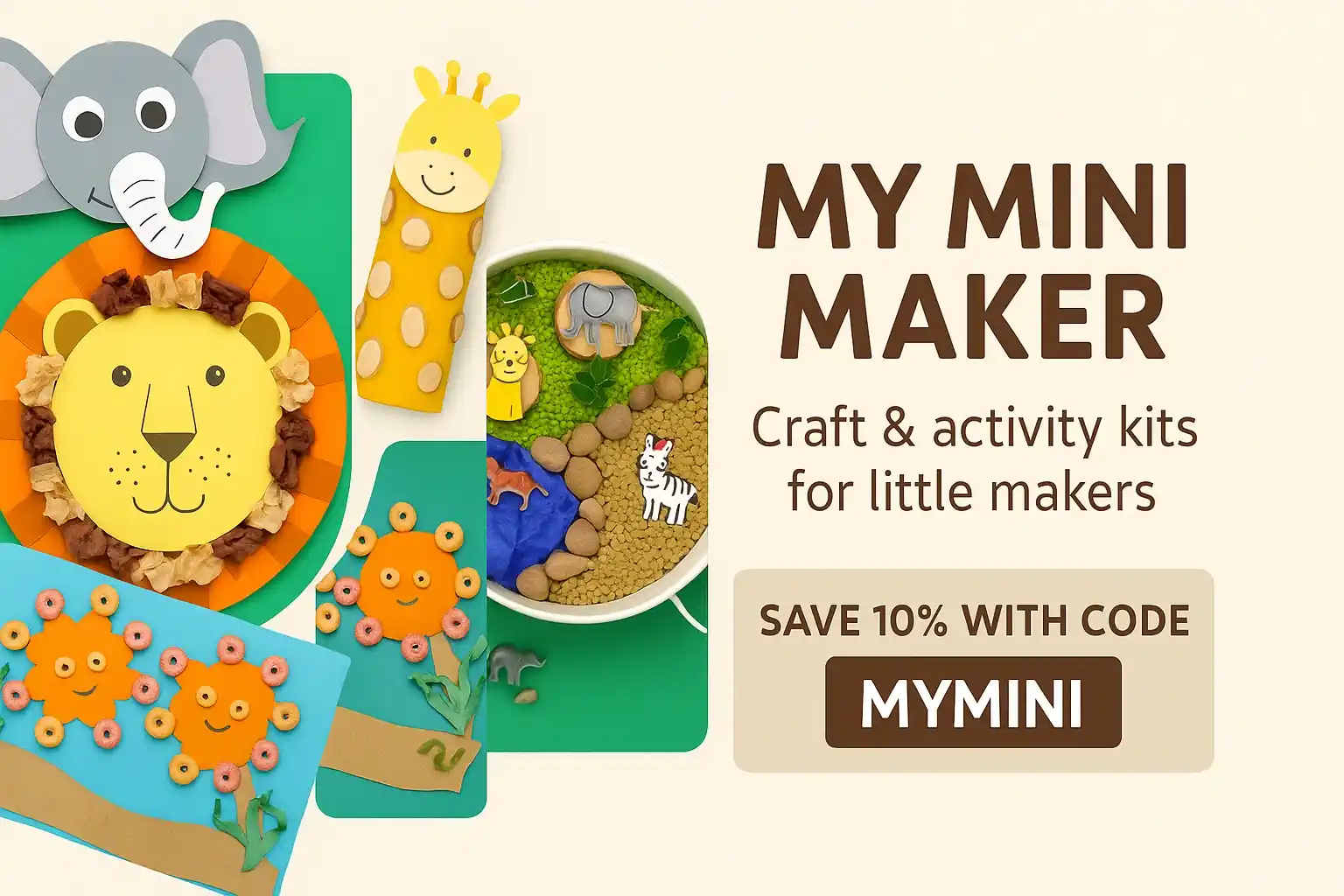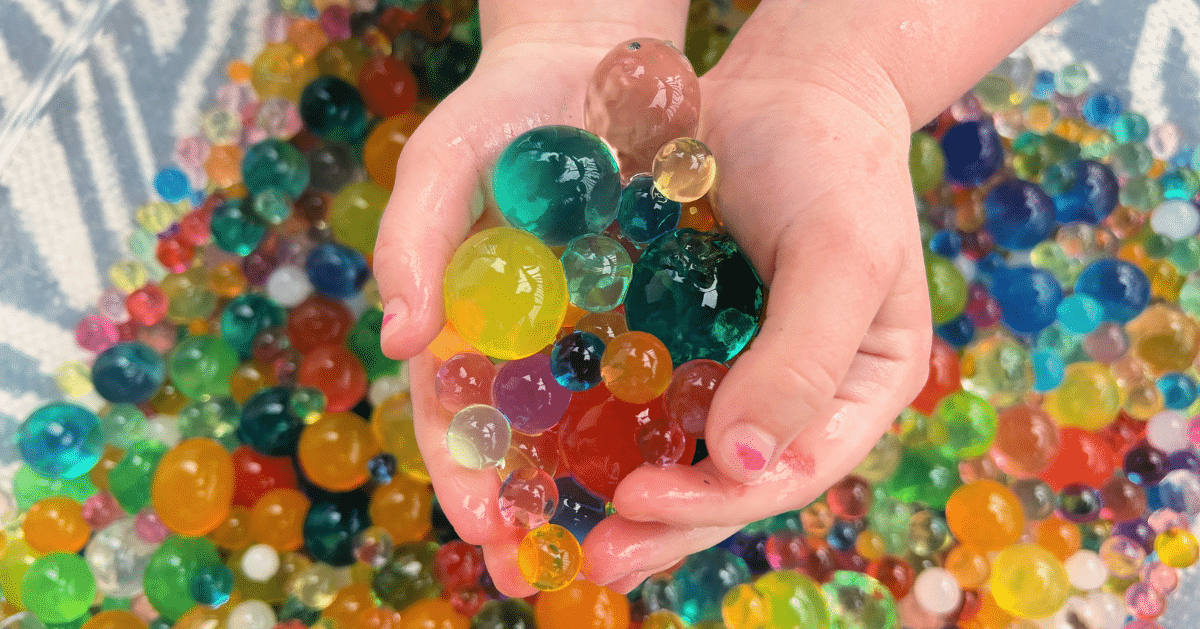Dive into Sensory Play: A Comprehensive Guide to Water Beads
Table of Contents
- Dive into Sensory Play: A Comprehensive Guide to Water Beads
- What are Water Beads & Why are They So Appealing?
- Safety First: Understanding the Risks & Precautions
- Where to Source Your Water Beads
- Hydrating Your Water Beads: A Step-by-Step Guide
- Inspiring Play: Activity Ideas for Water Beads
- Beyond Water Beads: Exploring Other Sensory Materials
- The Allure of Water Beads: Beyond Simple Play
- What are Water Beads and Why Do Kids Love Them?
- Creative Ways to Play with Water Beads
- 1. Sensory Exploration: A Tactile Delight
- 2. Illuminated Play: A Glowing Experience
- 3. Imaginative Worlds: Small Toys, Big Adventures
- 4. Color Sorting and Patterning: Learning Through Play
- 5. Fine Motor Skill Development: Scooping, Pouring, and Transferring
- Beyond the Basics: Creative Play Ideas with Water Beads
- The Allure of Water Beads: Why Kids Love Them
- Unleashing Creativity: Play Ideas for Water Beads
- 1. Sensory Bin Exploration
- 2. Colorful Sorting & Counting Games
- 3. Water Bead Mazes
- 4. Icy Adventures: Frozen Water Bead Play
- 5. Combining Textures: Water Beads & Shaving Cream
- 6. The Bounce Test
- Safety First: Understanding the Risks & Precautions
- Safer Alternatives for Little Ones
- Frequently Asked Questions
- Beyond Bubbles: Unlocking Development Through Water Bead Play
- The Science Behind the Sensory Appeal
- Cognitive Benefits: Learning Through Exploration
- Fostering Emotional Growth & Creativity
- Safe Play Practices: A Parent’s Guide
- Beyond the Bin: Creative Water Bead Activities
- Expanding Sensory Exploration: The Sensory Creativity Pack
- The Allure of Sensory Exploration
- Artistic Expressions with Expanding Spheres
- Creating Water Bead Art
- Educational Activities & STEM Learning
- Exploring Polymer Science
- Safety Considerations
Water beads have become a beloved staple in playful learning environments, captivating children with their unique texture and mesmerizing qualities. But what exactly are water beads, and how can you safely incorporate them into your child’s playtime? This guide will walk you through everything you need to know, from sourcing and hydrating these fascinating materials to exploring a world of engaging activities.
What are Water Beads & Why are They So Appealing?
Water beads are small, super-absorbent polymers that begin as tiny, hard granules. When hydrated, they expand dramatically, transforming into soft, squishy spheres that are incredibly tactile and visually stimulating. This unique transformation is part of the magic! Children are naturally drawn to their vibrant colors and the satisfying sensation of squeezing and manipulating them. They offer a fantastic opportunity to explore different textures and develop fine motor skills.
Safety First: Understanding the Risks & Precautions
While water beads offer a wealth of sensory benefits, safety is paramount. It’s crucial to understand that water beads are not edible and pose a serious choking hazard, especially for young children. If ingested, they can cause intestinal blockages requiring medical intervention.
Here are essential safety guidelines:
Constant Supervision: Never leave children unattended while playing with water beads.
Age Appropriateness: Water beads are best suited for children aged 3 and up, who understand not to put objects in their mouths.
Containment: Play with water beads in a designated area, ideally indoors, to prevent scattering and accidental ingestion.
Alternative Options: For younger children who still explore with their mouths, consider edible sensory materials like cooked pasta or gelatin.
Where to Source Your Water Beads
Water beads are readily available from a variety of retailers. You can often find them in the toy section of local drugstores or dollar stores, offering a budget-friendly option. Online marketplaces like Amazon also carry a wide selection of colors, sizes, and quantities.
Looking for something a little different? Consider purchasing giant water beads for a larger-scale sensory experience! Don’t forget to invest in helpful tools like sensory scoops to encourage exploration and develop hand-eye coordination.
Hydrating Your Water Beads: A Step-by-Step Guide
Activating water beads is a simple process, but requires a little patience. Here’s how to do it:
- Choose a Container: Select a clear storage bin or container large enough to accommodate the beads as they expand.
- Add the Beads: Pour the dehydrated beads into the container.
- Add Water: Cover the beads with plenty of water. The amount of water needed will vary depending on the quantity of beads.
- Wait & Observe: Allow the beads to soak for several hours, or even overnight, until they reach their full size. You’ll be amazed to watch them grow!
- Drain Excess Water: Once hydrated, drain any excess water before allowing your child to play.
The beads are made from a water-absorbing polymer, and as they absorb water, they will grow and grow. It’s a fascinating process to witness!
Inspiring Play: Activity Ideas for Water Beads
Once your water beads are hydrated, the possibilities for play are endless! Here are a few ideas to get you started:
Sensory Bin Exploration: Create a sensory bin filled with water beads and encourage your child to explore the texture with their hands.
Color Sorting: Provide a variety of colored water beads and challenge your child to sort them by color.
Counting & Math: Use water beads as manipulatives for counting, addition, and subtraction.
Fine Motor Practice: Encourage your child to pick up and transfer water beads using tongs or tweezers.
* Creative Play: Incorporate water beads into imaginative play scenarios, such as creating a “sea” for toy animals or a “garden” for miniature plants.
For more ideas on engaging sensory play, explore our guide to sensory play ideas for toddlers (https://thetrendytype.com/sensory-play-toddlers).
Beyond Water Beads: Exploring Other Sensory Materials
While water beads are a fantastic sensory material, it’s important to offer a variety of textures and experiences. Consider incorporating other materials like kinetic sand (https://thetrendytype.com/kinetic-sand-benefits) or play dough (https://thetrendytype.com/homemade-play-dough-recipes) into your child’s playtime to stimulate their senses and encourage creativity.
[Image of water beads with scoops: https://artfulparent.com/wp-content/uploads/2022/06/water-beads-with-scoops.png]
[Image of water beads hydrating: https://artfulparent.com/wp-content/uploads/2022/06/water-beads-hydrating.png]
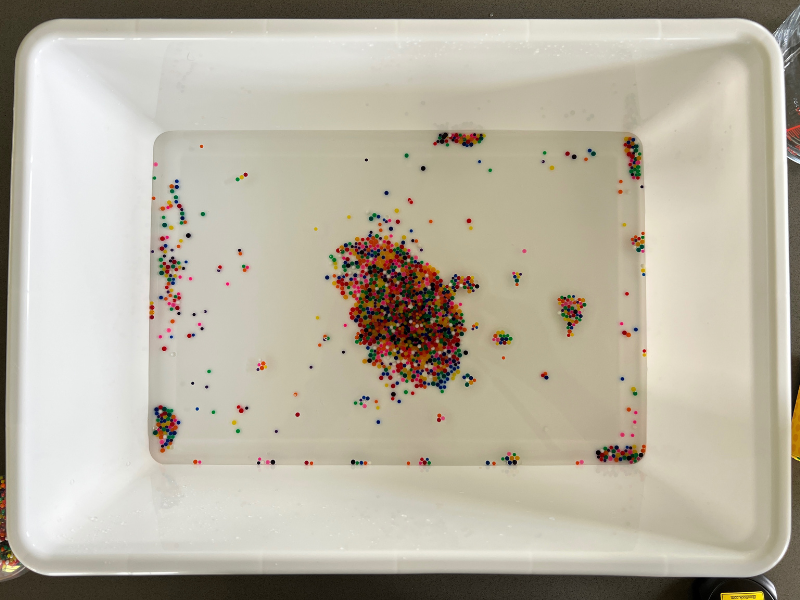
Witnessing the transformation of tiny, dehydrated orbs into plump, vibrant spheres is a captivating experience in itself. If the water beads absorb all the liquid, simply add more to continue the expansion process. Typically, it takes around 6-8 hours for them to reach their full size, but this can vary depending on the water temperature and the specific brand. The entire process is visually stimulating, and children often enjoy observing the beads at each stage of their growth, even the slightly bumpy, transitional phase!
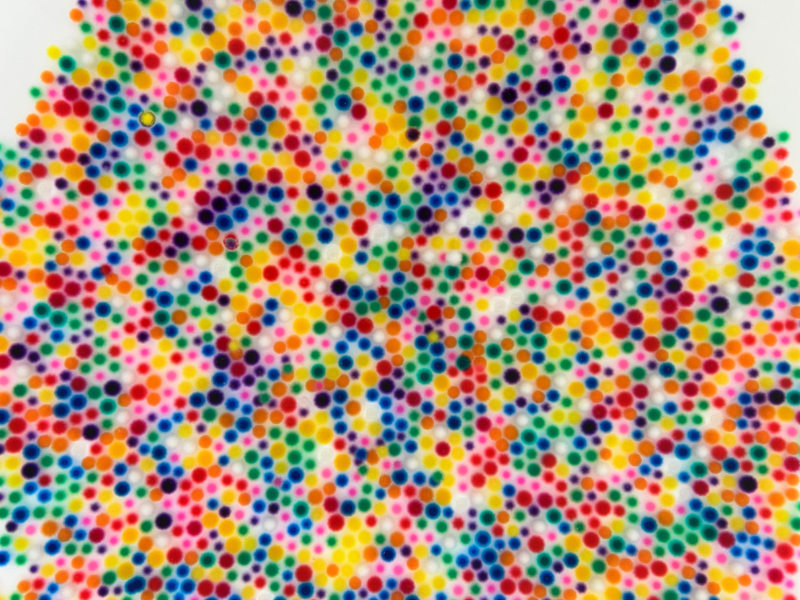
The Allure of Water Beads: Beyond Simple Play
Water beads have become a staple in many households with young children, and for good reason. These small, superabsorbent polymers offer a unique tactile experience and open up a world of creative possibilities. But what makes them so appealing, and how can you maximize their potential for engaging and educational play?
What are Water Beads and Why Do Kids Love Them?
Water beads are made from sodium polyacrylate, a material commonly used in diapers and other absorbent products. When soaked in water, they expand dramatically, creating soft, squishy spheres that are incredibly satisfying to touch. The cool, smooth texture and vibrant colors instantly capture a child’s attention. They offer a sensory experience unlike any other, stimulating curiosity and encouraging exploration. For children seeking calming sensory input, water beads can be particularly beneficial, offering a soothing and grounding experience.
Creative Ways to Play with Water Beads
Beyond simply handling the beads, there are countless ways to incorporate them into engaging activities. Here are a few ideas to spark your imagination:
1. Sensory Exploration: A Tactile Delight
Sensory play is where water beads truly shine. The captivating texture and visual appeal make them irresistible to children of all ages. The sensation of running the beads through their fingers, squeezing them, and observing how they move is incredibly stimulating. It’s a simple yet powerful way to encourage tactile exploration and develop fine motor skills. Consider creating a dedicated sensory bin filled with water beads and small tools like scoops, spoons, and containers to enhance the experience.
2. Illuminated Play: A Glowing Experience
Take the sensory experience to the next level by introducing water beads to a light table. The translucent beads glow beautifully when illuminated, creating a mesmerizing visual display. This is particularly captivating for younger children and can be used to explore colors, shapes, and patterns. If you’re looking for a DIY project, learn how to make your own light table and discover a wealth of engaging activities.
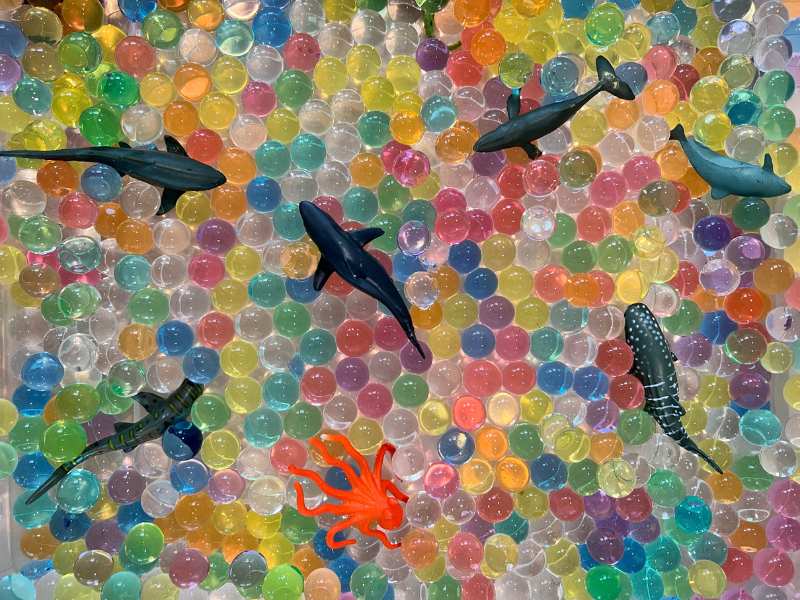
3. Imaginative Worlds: Small Toys, Big Adventures
Encourage imaginative play by adding small toys, such as miniature animals, dinosaurs, or figurines, to the water bead bin. Children can create their own miniature worlds, using the beads as water, sand, or other environmental elements. This fosters creativity, storytelling, and social-emotional development.
4. Color Sorting and Patterning: Learning Through Play
Water beads are an excellent tool for teaching color recognition, sorting, and patterning skills. Provide a variety of colored beads and challenge your child to sort them by color, create patterns, or build towers. This is a fun and engaging way to reinforce early math concepts. For a more advanced challenge, introduce different shapes and sizes of beads and encourage your child to sort and categorize them accordingly.
5. Fine Motor Skill Development: Scooping, Pouring, and Transferring
Water beads provide a fantastic opportunity to develop fine motor skills and hand-eye coordination. Provide a variety of tools, such as scoops, spoons, tongs, and small containers, and encourage your child to scoop, pour, and transfer the beads from one container to another. This activity helps strengthen the small muscles in their hands and fingers, preparing them for writing and other essential tasks.
Water beads offer a versatile and engaging play experience for children of all ages. By incorporating them into creative activities, you can foster their sensory development, fine motor skills, and imaginative thinking. Remember to always supervise children during water bead play and ensure they understand not to ingest the beads. For more ideas on enriching your child’s playtime, explore our resources on sensory materials and developmental play.
Beyond the Basics: Creative Play Ideas with Water Beads
Water beads have exploded in popularity as a captivating sensory material for children, offering a unique tactile experience and sparking imaginative play. But beyond simply observing these colorful, gel-like spheres, there’s a world of engaging activities to unlock. This guide delves into innovative ways to utilize water beads, alongside crucial safety considerations and alternatives for younger children.
The Allure of Water Beads: Why Kids Love Them
Water beads, also known as orbeez, are superabsorbent polymers that expand dramatically when soaked in water. This transformation is instantly mesmerizing for children, offering a visually stimulating and tactile experience. The cool, squishy texture provides a satisfying sensory input, promoting exploration and fine motor skill development. Beyond the sensory aspect, water beads naturally encourage counting, sorting, and color recognition – all valuable learning opportunities disguised as fun.
Unleashing Creativity: Play Ideas for Water Beads
Here are some exciting ways to incorporate water beads into playtime:
1. Sensory Bin Exploration
The classic water bead sensory bin remains a favorite for a reason. Fill a shallow container with hydrated water beads and provide scoops, cups, and small toys for children to explore. Encourage them to pour, scoop, and bury objects within the beads, fostering hand-eye coordination and imaginative scenarios. Consider adding themed elements like miniature animals for a “sea life” bin or construction vehicles for a “construction site” adventure.
2. Colorful Sorting & Counting Games
Water beads are perfect for reinforcing early math skills. Provide a variety of colors and challenge children to sort them into separate containers. Extend the activity by asking them to count the beads in each container or create patterns based on color. This hands-on approach makes learning fun and engaging.
3. Water Bead Mazes
Create a simple maze using cardboard or plastic containers. Children can then use a chopstick or small tool to guide water beads through the maze, developing problem-solving skills and hand dexterity. This activity encourages focus and concentration.
4. Icy Adventures: Frozen Water Bead Play
For a refreshing twist, freeze water beads in ice cube trays or larger containers. Once frozen, children can excavate the beads using small tools, providing a unique sensory experience and promoting fine motor skills. This is particularly enjoyable during warmer months.
5. Combining Textures: Water Beads & Shaving Cream
Elevate the sensory experience by mixing water beads with shaving cream. The contrasting textures create a delightfully messy and engaging activity. Children can swirl, scoop, and explore the combined materials, fostering creativity and sensory exploration. This is a fantastic way to reinvigorate play after they’ve become accustomed to the beads on their own.
6. The Bounce Test
While not the primary purpose, water beads do possess a surprising bounce! Supervise children as they gently drop beads from a low height, observing the scattering effect. This can lead to discussions about gravity and motion.
Safety First: Understanding the Risks & Precautions
While water beads offer numerous benefits, it’s crucial to be aware of the potential hazards. Water beads pose a serious choking hazard, especially for young children. If ingested, they can cause intestinal blockage, requiring medical intervention.
Here are essential safety precautions:
Constant Supervision: Never leave children unattended while playing with water beads.
Age Appropriateness: Water beads are not suitable for children under the age of 3.
Proper Disposal: Ensure all beads are accounted for after playtime. Dried beads can still pose a hazard if rehydrated.
Educate Children: Teach children not to put water beads in their mouths.
For more information on child safety and sensory play, explore resources on sensory play ideas at https://thetrendytype.com/sensory-play.
Safer Alternatives for Little Ones
For babies and toddlers who may be tempted to put objects in their mouths, consider these safer alternatives:
Tapioca Pearls: Cooked tapioca pearls offer a similar texture and visual appeal without the choking hazard.
Edible Mini Water Beads: Several brands offer edible, non-chokable mini water beads made from fruit-based gels.
Frequently Asked Questions
What are the dangers of water beads? They are a choking hazard and can cause serious health risks if ingested. Never allow a child to use them unsupervised.
Do water beads need to stay in water? Yes, they will shrink as the water evaporates. You can store hydrated beads in an airtight container for future use.
Do water beads ever dry out? They will shrink up as the water evaporates, so you can leave them out for a few days to dry out and shrink.
How do you dispose of water beads? Once they have dried out and are back to their original size, you can dispose of them. If the packaging confirms they are biodegradable, you can bury them in your garden.
Beyond Bubbles: Unlocking Development Through Water Bead Play
Water beads have exploded in popularity as a captivating sensory material for children, and for good reason. These tiny, colorful spheres offer a unique tactile experience that goes far beyond simple entertainment. But what is it about water beads that makes them so beneficial for growing minds, and how can parents and educators maximize their developmental potential? This article delves into the world of water bead play, exploring its cognitive, emotional, and physical benefits, alongside practical tips for safe and engaging activities.
The Science Behind the Sensory Appeal
Sensory play is crucial for early childhood development, stimulating the senses and fostering brain connections. Water beads excel in this area due to their distinct properties. Their squishy, slippery texture provides a fascinating contrast to other materials, encouraging exploration and fine motor skill development. The visual appeal of the vibrant colors also captivates children, promoting visual discrimination and concentration.
According to a recent study by the National Association for the Education of Young Children (NAEYC), children who regularly engage in sensory play demonstrate improved problem-solving abilities and emotional regulation. Water beads, with their malleable nature, offer endless opportunities for experimentation and creative expression.
Cognitive Benefits: Learning Through Exploration
Water bead play isn’t just about tactile sensation; it’s a powerful tool for cognitive development. Activities involving water beads can be easily adapted to reinforce a variety of concepts:
Math Skills: Counting beads, sorting by color, and comparing quantities introduce foundational math concepts in a playful way.
Science Exploration: Observing how beads absorb water, understanding volume, and exploring buoyancy are simple science lessons in action.
Problem-Solving: Children can experiment with different tools to manipulate the beads, fostering critical thinking and problem-solving skills. For example, can they use a spoon to transfer beads from one container to another without spilling?
Language Development: Describing the texture, color, and movement of the beads expands vocabulary and encourages descriptive language.
Fostering Emotional Growth & Creativity
Beyond cognitive benefits, water bead play provides a safe and engaging outlet for emotional expression. The tactile experience can be calming and soothing, particularly for children who are anxious or overstimulated. The open-ended nature of the activity encourages creativity and imagination. Children can create miniature worlds, design patterns, or simply enjoy the sensory experience without any prescribed outcome.
This type of unstructured play is vital for developing emotional resilience and self-confidence. It allows children to take risks, experiment with ideas, and learn from their mistakes in a supportive environment. Looking for more ways to encourage creative play? Explore our guide to sensory bins for endless inspiration: https://thetrendytype.com/why-sensory-play-is-important-10-sensory-bin-ideas-for-kids/.
Safe Play Practices: A Parent’s Guide
While water beads offer numerous benefits, safety is paramount. Unsupervised play with water beads can pose a choking hazard, especially for young children. Here are essential safety guidelines:
Supervision is Key: Always supervise children during water bead play.
Age Appropriateness: Water beads are generally recommended for children ages 3 and up.
Containment: Play with water beads should be confined to a designated area, such as a shallow bin or tray.
Proper Disposal: Never allow water beads to be flushed down the toilet or drain, as they can cause blockages. Dispose of them properly in the trash.
Non-Toxic Beads: Ensure the water beads are made from non-toxic materials.
Beyond the Bin: Creative Water Bead Activities
Here are a few ideas to spark your imagination:
Color Sorting: Provide a variety of colored beads and ask children to sort them into corresponding containers.
Bead Maze: Create a simple maze using cardboard tubes and encourage children to guide beads through the maze using their fingers or a tool.
Sensory Writing Tray: Spread a thin layer of hydrated beads in a tray and let children practice writing letters or drawing shapes with their fingers.
* Ocean Sensory Play: Combine blue-tinted water beads with small plastic sea creatures to create an immersive ocean sensory experience.
Want to dive deeper into the world of sensory materials? Check out our ultimate guide to sensory play for a comprehensive overview: https://thetrendytype.com/best-kids-sensory-materials/.
Expanding Sensory Exploration: The Sensory Creativity Pack
Looking for a curated collection of sensory play ideas and recipes? Our Sensory Creativity Pack is a 30-page printable eBook packed with inspiration for hours of sensory fun! It’s the ultimate guide to unlocking your child’s potential through sensory exploration.
https://thetrendytype.com/super-sensory-creativity-pack/
Beyond the Bead: Creative Activities with Water Beads
Water beads—those tiny, colorful spheres that expand when soaked in water—have become a sensation, captivating children and adults alike with their unique texture and visual appeal. But beyond simply observing their expansion, a world of creative possibilities awaits. This article explores engaging and safe ways to utilize water beads, transforming them from a novelty item into a versatile tool for sensory play, artistic expression, and even educational activities.
The Allure of Sensory Exploration
The primary draw of water beads lies in their captivating sensory qualities. The cool, slippery texture is instantly appealing, providing a unique tactile experience. For young children, particularly those exploring their senses, water beads offer a safe and stimulating way to develop fine motor skills and hand-eye coordination. Unlike traditional playdough or slime, water beads offer a different kind of resistance and flow, encouraging exploration and experimentation.
Consider incorporating water beads into a “sensory bin.” Combine them with scoops, small containers, and miniature toys to create a miniature world for imaginative play. This activity is particularly beneficial for toddlers and preschoolers, fostering creativity and problem-solving skills. For a calming experience, create a “water bead ocean” – a shallow tray filled with blue-tinted water beads and small plastic sea creatures.
Artistic Expressions with Expanding Spheres
Water beads aren’t just for tactile exploration; they can also be incorporated into stunning artistic projects. Their translucent quality makes them ideal for creating vibrant mosaics and collages.
Creating Water Bead Art
Here’s a simple project to get you started:
- Prepare Your Surface: Use a piece of cardboard, canvas, or sturdy plastic as your base.
- Adhesive Application: Apply a thin layer of clear craft glue or Mod Podge to the desired area.
- Bead Placement: Carefully place the water beads onto the adhesive, creating your desired pattern or design.
- Drying Time: Allow the glue to dry completely before displaying your artwork.
For a more three-dimensional effect, consider creating a water bead sculpture. Use wire or skewers to support the beads, building up layers to create a unique and eye-catching piece. This is a fantastic way to introduce children to basic sculpting techniques. If you’re looking for more art ideas, explore our guide to DIY Art Projects for inspiration.
Educational Activities & STEM Learning
Water beads offer a surprisingly effective way to introduce basic scientific concepts. The expansion process itself is a fascinating demonstration of absorption and polymers.
Exploring Polymer Science
Explain to children that water beads are made of a special material called a polymer, which can absorb and hold a lot of water. Discuss how this is different from other materials, like wood or metal.
You can also turn water bead play into a math lesson. Have children sort the beads by color, count them, and create patterns. This reinforces counting skills and introduces basic concepts of categorization and sequencing. For older children, you can introduce the concept of volume by measuring how much water it takes to fully hydrate a certain number of beads.
Looking for more ways to engage kids in learning? Check out our article on STEM Activities for Kids.
Safety Considerations
While water beads are generally safe, it’s crucial to supervise children during play, especially younger ones. Swallowing water beads can be dangerous and cause intestinal blockage. Always emphasize that water beads are not food and should not be put in the mouth.
Here are some additional safety tips:
Use larger beads: Larger beads are less likely to be swallowed.
Supervise closely: Never leave young children unattended with water beads.
Proper disposal: Do not flush water beads down the toilet or drain, as they can cause plumbing problems. Dispose of them in the trash.
Storage: Store dry, unused beads in a secure location out of reach of children.
For more information on child safety and play, visit Safe Play Ideas.

